教学设计(丽声拼读故事会第一级 Bob Bug)
- 格式:doc
- 大小:9.11 MB
- 文档页数:7
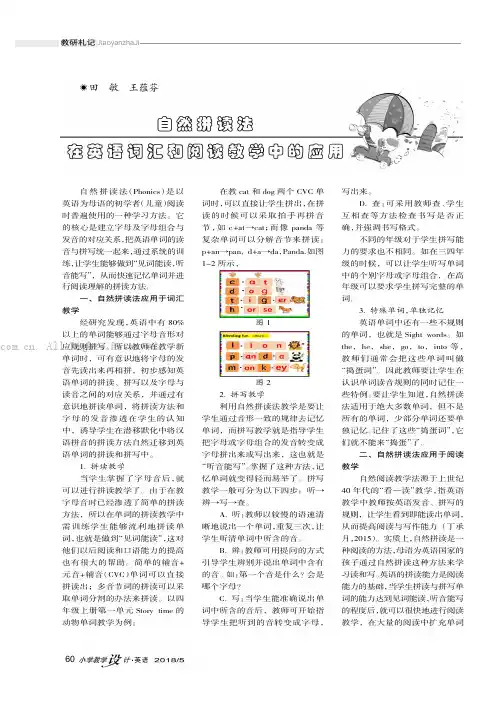
自然拼读法(Phonics )是以英语为母语的初学者(儿童)阅读时普遍使用的一种学习方法。
它的核心是建立字母及字母组合与发音的对应关系,把英语单词的读音与拼写统一起来,通过系统的训练,让学生能够做到“见词能读,听音能写”,从而快速记忆单词并进行阅读理解的拼读方法。
一、自然拼读法应用于词汇教学经研究发现,英语中有80%以上的单词能够通过字母音形对应规则拼写。
所以教师在教学新单词时,可有意识地将字母的发音先读出来再相拼,初步感知英语单词的拼读、拼写以及字母与读音之间的对应关系,并通过有意识地拼读单词,将拼读方法和字母的发音渗透在学生的认知中,诱导学生在潜移默化中将汉语拼音的拼读方法自然迁移到英语单词的拼读和拼写中。
1.拼读教学当学生掌握了字母音后,就可以进行拼读教学了。
由于在教字母音时已经渗透了简单的拼读方法,所以在单词的拼读教学中需训练学生能够流利地拼读单词,也就是做到“见词能读”,这对他们以后阅读和口语能力的提高也有很大的帮助。
简单的辅音+元音+辅音(CVC )单词可以直接拼读出;多音节词的拼读可以采取单词分割的办法来拼读。
以四年级上册第一单元Story time 的动物单词教学为例:在教cat 和dog 两个CVC 单词时,可以直接让学生拼出,在拼读的时候可以采取拍手再拼音节,如c +at →cat ;而像panda 等复杂单词可以分解音节来拼读:p+an→pan,d+a→da ,Panda.如图1-2所示,图1图22.拼写教学利用自然拼读法教学是要让学生通过音形一致的规律去记忆单词,而拼写教学就是指导学生把字母或字母组合的发音转变成字母拼出来或写出来,这也就是“听音能写”。
掌握了这种方法,记忆单词就变得轻而易举了。
拼写教学一般可分为以下四步:听→辨→写→查。
A.听:教师以较慢的语速清晰地说出一个单词,重复三次,让学生听清单词中所含的音。
B.辨:教师可用提问的方式引导学生辨别并说出单词中含有的音。
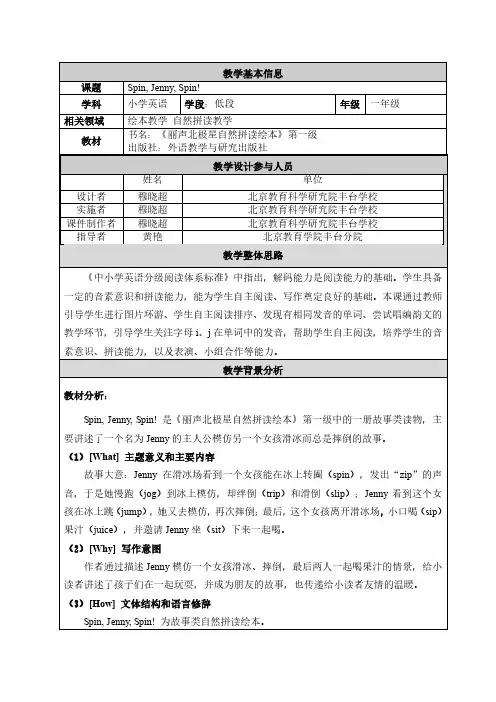
,go ice-skating提前渗透在单词中的发音。
学生通过观察,发现滑冰技术较好的女孩,教师启发学生预测故事情What do you see in the cover? Where are they? What are they doing?。
课件播放一段短视频解释词汇spin,师生一起齐读词the sound of moving very fast)所说的语言,学生听录音模仿语句“I can do排序,教师可让学生翻看书以作参考。
教师可邀请一名学生完成板书上的图片排序。
What will happen next? You can open your books and match the pictures with the correct自主阅读,一方面可锻炼学生动手能力,另一方面也可检测学生对故事的理解。
,共读P7I can do that!”页,学生观察两个女孩的动作。
师生在进行模仿跟读后,共同表页:教师读句子,学生进行动作表演;而后学生读句子,教师做动作。
动作表演带动作表演。
在表演、模仿、跟读的过程中,进一步体会字母i和j在单词中的发音。
【设计意图】为帮助学生理解,这一环节融入了师生表演的教学活动,可引导学生在表演的过程中,更好地理解文本意义,同时为下一环节的两人一组表演做铺垫。
听读、表【设计意图】通过思考两人对话,可调动学生主动思考并进行表达的欲望,而Jill这一【效果评价】学生能够和教师一起说唱韵文,并在教师给出的例子支撑下,运用含有字【设计意图】这一环节在引导学生感知、识别音素后,根据故事大意编唱韵文,是从输入到输出的过程。
此过程进一步提升了学生的阅读和表达能力,并让学生在韵文中感知。
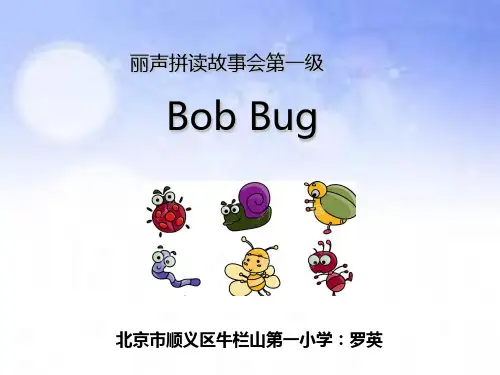
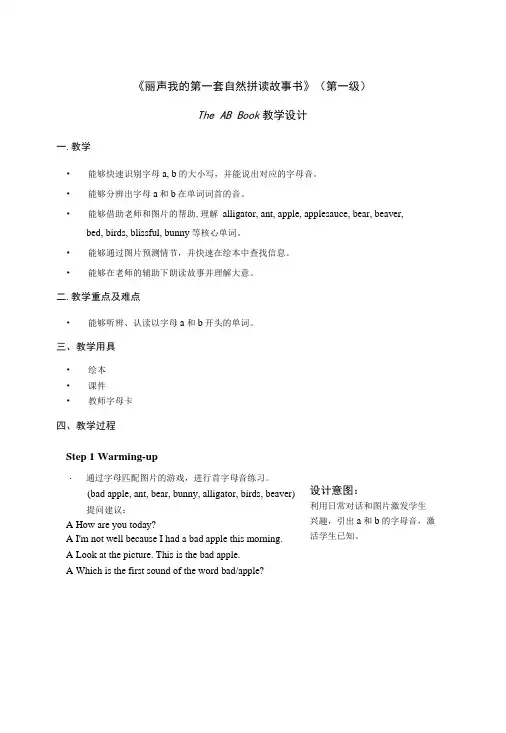
《丽声我的第一套自然拼读故事书》(第一级)The AB Book教学设计一.教学•能够快速识别字母a, b的大小写,并能说出对应的字母音。
•能够分辨出字母a和b在单词词首的音。
•能够借助老师和图片的帮助,理解alligator, ant, apple, applesauce, bear, beaver, bed, birds, blissful, bunny 等核心单词。
•能够通过图片预测情节,并快速在绘本中查找信息。
•能够在老师的辅助下朗读故事并理解大意。
二.教学重点及难点•能够听辨、认读以字母a和b开头的单词。
三、教学用具•绘本•课件•教师字母卡四、教学过程Step 1 Warming-up・通过字母匹配图片的游戏,进行首字母音练习。
(bad apple, ant, bear, bunny, alligator, birds, beaver) 提问建议:A How are you today?A I'm not well because I had a bad apple this morning.A Look at the picture. This is the bad apple.A Which is the first sound of the word bad/apple?设计意图:利用日常对话和图片激发学生兴趣,引出a和b的字母音,激活学生已知。
Step 2 Phonics・引导学生识别出每个单词中的第一个音素。
提问建议:A Now please look at the pictures and listen to me.A What is this?A Which is the first sound of the word ant?A Tell me whether the first sound is /a/ or /b/.A Which is the first sound of the word bear/bunny/alligator/birds/beaver?A Make a summary of the two sounds.教师用语:A So we have .../a/ /a/ for ant, /a/ for alligatorA And we have .../b/ /b/ for bear...Step 3 Pre-reading・引导学生看图,并回答以下问题。
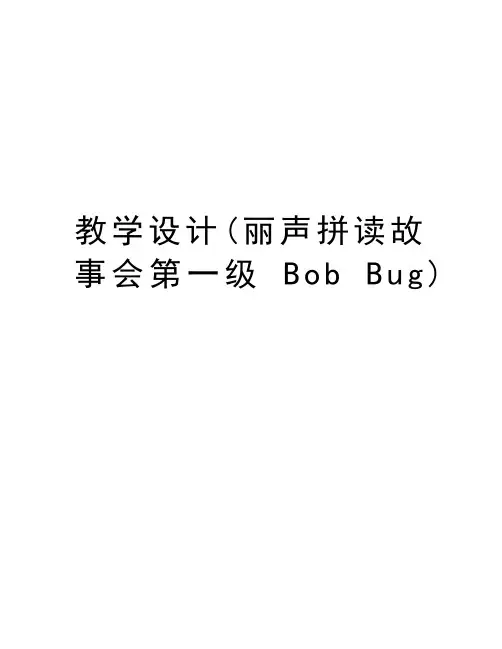
教学设计(丽声拼读故事会第一级B o b B u g)学校北京市顺义区牛栏山第一小学年级一年级教材《丽声拼读故事会》(第一级)课题Bob Bug 教师罗英教学内容(2) 引入本课奖励机制:T: Bug? What is a bug? Look, I’ve got many beautiful bugs here. Do you want the m? You give me 3 stickers, and I can give you one bug. So be good and work hard today!设计意图:通过常规化的音素合成能力训练,复习本节课文本即将涉及到的a i o u b c d f g h l m p r t字母音,并初步拼读这些字母音组合的VC, CVC单词,为后面的快速解码故事文本做准备。
3. 绘本共读(1) 读前活动a) 观察封面,认读绘本的题目,熟悉故事主角,激发对故事内容的好奇。
T: What can you see on the cover page? (a ball, a bug…)T: What’s the bug’s name? 播放音频“Bob is a bug.”T: Bob bug has a ball. Bob bug also has a red T-shirt. Bob bug has red shoes.再以教师自己的书、包及班上学生的书包、校服等为例,强化理解hasT: In the book, Bob has many good things. Do you wan t to know? Let’s listen and see what Bob has.整体视听绘本。
设计意图:通过观察讨论封面,引导学生认读标题,初步认识主角,并激发对接下来阅读内容的好奇。
以身边实物举例,能更生动形象地帮助学生理解本课的核心词及抽象词has含义。
(2) 读中活动a) 阅读P1-5,解答问题1“What does Bob have?”,从而完成Bob (Bug) has …这个句型及所含核心词的理解和认读,及故事结构的第一轮梳理。
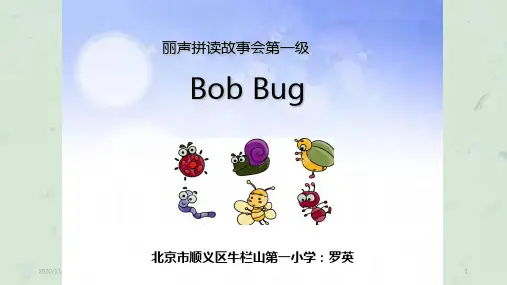
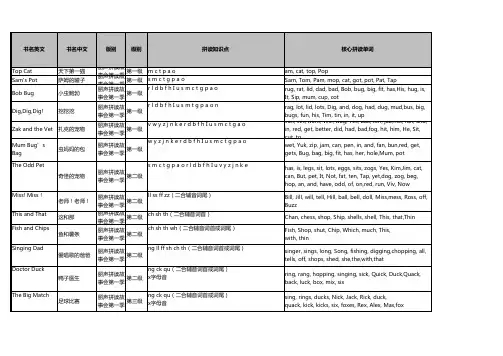
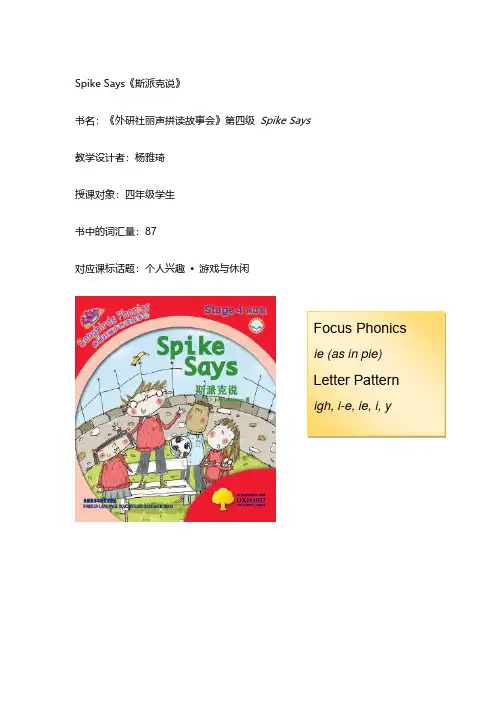
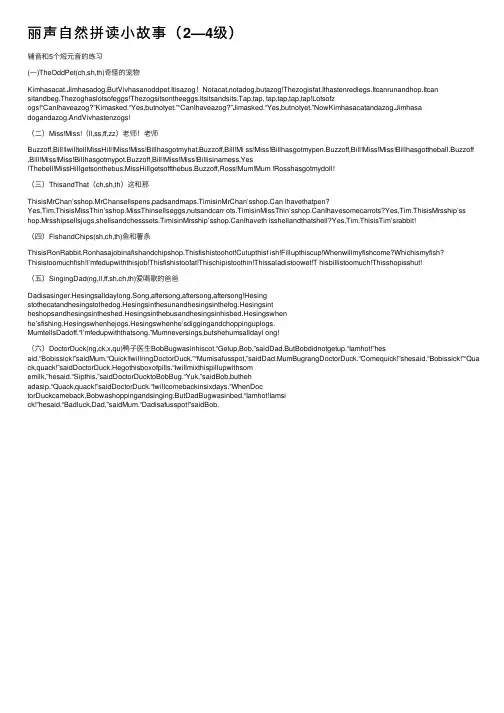
丽声⾃然拼读⼩故事(2—4级)辅⾳和5个短元⾳的练习(⼀)TheOddPet(ch,sh,th)奇怪的宠物Kimhasacat.Jimhasadog.ButVivhasanoddpet.Itisazog!Notacat,notadog,butazog!Thezogisfat.Ithastenredlegs.Itcanrunandhop.Itcan sitandbeg.Thezoghaslotsofeggs!Thezogsitsontheeggs.Itsitsandsits.Tap,tap, tap,tap,tap,tap!Lotsofzogs!“CanIhaveazog?”Kimasked.“Yes,butnotyet.”“CanIhaveazog?”Jimasked.“Yes,butnotyet.”NowKimhasacatandazog.Jimhasa dogandazog.AndVivhastenzogs!(⼆)Miss!Miss!(ll,ss,ff,zz)⽼师!⽼师Buzzoff,Bill!IwilltellMissHill!Miss!Miss!Billhasgotmyhat.Buzzoff,Bill!Mi ss!Miss!Billhasgotmypen.Buzzoff,Bill!Miss!Miss!Billhasgottheball.Buzzoff ,Bill!Miss!Miss!Billhasgotmypot.Buzzoff,Bill!Miss!Miss!Billisinamess.Yes!Thebell!MissHillgetsonthebus.MissHillgetsoffthebus.Buzzoff,Ross!Mum!Mum !Rosshasgotmydoll!(三)ThisandThat(ch,sh,th)这和那ThisisMrChan’sshop.MrChansellspens,padsandmaps.TimisinMrChan’sshop.Can Ihavethatpen?Yes,Tim.ThisisMissThin’sshop.MissThinsellseggs,nutsandcarr ots.TimisinMissThin’sshop.CanIhavesomecarrots?Yes,Tim.ThisisMrsship’ss hop.Mrsshipsellsjugs,shellsandchesssets.TimisinMrsship’sshop.CanIhaveth isshellandthatshell?Yes,Tim.ThisisTim’srabbit!(四)FishandChips(sh,ch,th)鱼和薯条ThisisRonRabbit.Ronhasajobinafishandchipshop.Thisfishistoohot!Cutupthisf ish!Fillupthiscup!Whenwillmyfishcome?Whichismyfish? Thisistoomuchfish!I’mfedupwiththisjob!Thisfishistoofat!Thischipistoothin!Thissaladistoowet!T hisbillistoomuch!Thisshopisshut!(五)SingingDad(ng,ll,ff,sh,ch,th)爱唱歌的爸爸Dadisasinger.Hesingsalldaylong.Song,aftersong,aftersong,aftersong!Hesingstothecatandhesingstothedog.Hesingsinthesunandhesingsinthefog.Hesingsintheshopsandhesingsintheshed.Hesingsinthebusandhesingsinhisbed.Hesingswhenhe’sfishing.Hesingswhenhejogs.Hesingswhenhe’sdiggingandchoppinguplogs.MumtellsDadoff.“I’mfedupwiththatsong.”Mumneversings,butshehumsalldayl ong!(六)DoctorDuck(ng,ck,x,qu)鸭⼦医⽣BobBugwasinhiscot.“Getup,Bob,”saidDad.ButBobdidnotgetup.“Iamhot!”hesaid.“Bobissick!”saidMum.“Quick!IwillringDoctorDuck.”“Mumisafusspot,”saidDad.MumBugrangDoctorDuck.“Comequick!”shesaid.“Bobissick!”“Qua ck,quack!”saidDoctorDuck.Hegothisboxofpills.“Iwillmixthispillupwithsomemilk,”hesaid.“Sipthis,”saidDoctorDucktoBobBug.“Yuk,”saidBob,buthehadasip.“Quack,quack!”saidDoctorDuck.“Iwillcomebackinsixdays.”WhenDoctorDuckcameback,Bobwashoppingandsinging.ButDadBugwasinbed.“Iamhot!Iamsick!”hesaid.“Badluck,Dad,”saidMum.“Dadisafusspot!”saidBob.。

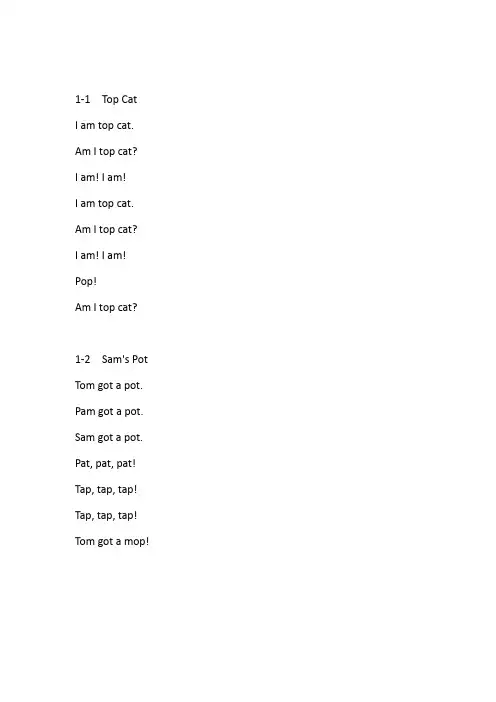
1-1 Top Cat I am top cat. Am I top cat?I am! I am!I am top cat. Am I top cat?I am! I am! Pop!Am I top cat?1-2 Sam's Pot Tom got a pot. Pam got a pot. Sam got a pot. Pat, pat, pat! Tap, tap, tap! Tap, tap, tap! Tom got a mop!1-3Bob BugBob is a bug.Bob bug has a mum.His mum is big. Bob has a dad.His dad is fit.Bob has a cup. It has a lid.Bob has a cot. His cot has a rug. Mum! Dad! A big bad rat!Bob Bug has a hug.1-4 Dig,Dig,DigDig,dig, dig!Tim and his dog had fun.Dig, dig, dig.Tim dug up a lot of mud.Dig, dig, dig.His dog dug up a rag.Dig, dig, dig.Tim dug up a bus.Dig, dig, dig.A Lid!Dig, dig, dig.A big tin!And in it...Lots of bugs!1-6 Mum BugMum Bug has a red bag. The bag has a zip.Mum can fit a pen in her bag.Mum can fit a pen and a fan in her bag.Mum can fit a pen and a fan and a bun in her bag.Mum can fit a pen and a fan and a bun and a pot of jam in her bag. Mum has a hole in her bag!The pen and the fan and the bun and the jam get wet.Mum Bug gets a big bag.1-7 Zak and the Vet“Sit, Zak. Sit!”Zak did not sit. Zak ran.“Sit, Zak. Sit!”Zak ran and ran!Zak ran in the fog.A red van hit him.Jen and Zak went to the vet.Zak had a bad cut. He had to get a jab.“Will Zak get better?”“Yes.”Zak did get better.Wag. Wag. Wag.。
教学内容:外研社丽声拼读故事会第一级Bob Bug教学目标:1、巩固CVC单词的拼读。
2、尝试拼读、朗读故事。
3、借助故事,学生能够体会到父母的爱。
教学重点:1、拼读、朗读故事。
2、理解故事大意。
教学难点:自己运用拼读,朗读故事。
教学准备:字母卡30套、故事书30本、多媒体课件、字母卡磁贴、小虫贴画等。
教学过程:1. Revision(1) Greeting and sing Hello song.T: Hello, everyone. Now, let’s sing a song, and say hello to your friend.(2) Sing phonics song.T: Today, let’s go to the phonics park. There are many letters in the park. They all have their own names and sounds. Let’s sing together.(3) Say short vowels chant.T: Look at the alphabet, there are five red letters. They are special. What are they? Tell me together. Who can help me pick it out? (学生持卡站好,并说歌谣。
)(4) Blend wordsT: L et’s make some words with letters. (老师把卡片贴在黑板上,学生读。
) 1)ratT: Show me rat. (学生回答。
)2)cutT: Who can show me cut? (学生回答。
)3)notT: I can read like this: n-o-t-not. (老师手指着字母示范读单词。
) Who can? 4)net & nitT: Who want to try?5)Read in pairs.bad, get, mum, dad, Bob, bug, cup, lid, cot, fit, leg, sit, hug6)FeedbackRead one by one.(5) Meaning checkcupT: Do you have a cup? I have a cup. What color is it? And what’s this? (拿杯盖放在单词lid旁。
学校北京市顺义区牛栏山第一小学年级一年级
教材《丽声拼读故事会》(第一级)课题Bob Bug
教师罗英
教学内容
指导思想与理论依据
当前,英语课程的改革从培养学生的综合语言运用能力到关注学生核心素养的培养,具体表现为语言能力、文化品格、思维品质、学习能力四个方面。
面对新要求,在小学英语阅读教学中,我们应当通过整合儿歌、短文、故事形式多样的内容来发展语言能力,帮助学生掌握基本的英语语音知识,发展基本的英语听、说、读、写技能,初步形成用英语与他人交流的能力,进一步促进学生思维能力的发展,同时提高学生的综合人文素养。
同时,《英语课程标准(2011版)》二
Ss逐个完成拼读练习
(2) 引入本课奖励机制:
T: Bug? What is a bug? Look, I’ve got many beautiful bugs here. Do you
want them? You give me 3 stickers, and I can give you one bug. So be good
and work hard today!
设计意图:通过常规化的音素合成能力训练,复习本节课文本即将涉及到的a i o u b c d f g h l m p r t字母音,并初步拼读这些字母音组合的VC, CVC单词,为后面的快速解码故事文本做准备。
3. 绘本共读
(1) 读前活动
a) 观察封面,认读绘本的题目,熟悉故事主角,激发对故事内容的好奇。
T: What can you see on the cover page? (a ball, a bug…)
T: What’s the bug’s name? 播放音频“Bob is a bug.”
T: Bob bug has a ball. Bob bug also has a red T-shirt. Bob bug has red shoes.
再以教师自己的书、包及班上学生的书包、校服等为例,强化理解has
T: In the book, Bob has many good things. Do you want to know? Let’s listen and se e what Bob has.
整体视听绘本。
设计意图:通过观察讨论封面,引导学生认读标题,初步认识主角,并激发对接下来阅读内容的好奇。
以身边实物举例,能更生动形象地帮助学生理解本课的核心词及抽象词has含义。
(2) 读中活动
a) 阅读P1-5,解答问题1“What does Bob have?”,从而完成Bob (Bug) has …这个句型及所含核心词的理解和认读,及故事结构的第一轮梳理。
T: What does Bob have? 学生根据所听自由回答问题。
T: Well, we can read the book to find out what Bob has. For example, page 2, Bob Bug has a mum.
T: Now you open your book, read page 1-5, take your pencil and circle the words of things that Bob has. (此处根据情况,可用中文解释)
学生阅读P1-5,圈出核心词mum, dad, cup, cot.
T带全班检查答案,并完成每页第一句话的认读,及核心词词义确认。
其中cot 是难点,通过paraphrase, 图片,提问等确认意义。
b) 阅读P1-5,解答问题2“How does … look?”,从而完成”His … is…”, “It has a…”句型及所含核心词的理解和认读,及故事结构的第二轮梳理。
T: From P1-5, we know Bob bug has a mum, Bob …? 学生根据图片提示,完成Bob has …句子复述。
T:Look at Mum. How does Mum look? (运用镜子教具,处理本问题的意思)T: Is she big or small?
T: I’ll circle “big”. This word tells how mum looks. How does his dad/cup/cot look? Can you circle the words?
学生阅读P1-5,圈出核心词big, fit, lid, rug.
T带全班检查答案,并完成每页第二句话的认读,及核心词词义确认。
其中fit, lid, rug为难点,通过图片举例及TPR完成词义确认。
c) 共读P6-8,完成整个故事的理解,及拓展讨论。
P5
T:It’s night. Bob is going to sleep. What will mum say? What will dad do? Let’s say good night to Bob.
P6&7
T:But is Bob sleeping? No, he looks a bit scared.
T:What does he see?
T:Is the rat big or small? Is the rat good or bad?
T:What does Bob say?
T:Poor Bob, what can he do? Will Mum and Dad come?
P8
Yes. Mum and Dad come, and Bob Bug has a …
设计意图:前5页,通过两个核心问题“What does Bob (Bug) have?”, “How does Mum/Dad/Cup/Cot look?”的解答,梳理了故事的逻辑线,在寻读、拼读、共读的
过程中,完成核心词汇的理解和认读,并辅以板书,完成了故事框架的构建;随后P6-8,通过师生共读,观察讨论绘本图文,完成故事的情感部分的理解体会。
(3) 读后活动
a) 拓展讨论:
T:Is Bob still scared? Why? T可以提示: Because Mum and Dad are here. Mum is big. Dad is fit. They love him, and can protect him!
T:When you are scared, who will you call? Mum, Dad, Grandma, Grandpa? Why? 学生联系自己的生活,回答问题。
b) 朗读练习:
学生听原音频和跟读;学生跟着老师读;分小组读;组内练习朗读
c) 朗读展示:
小组朗读展示。
d)听唱chant, 感知韵律节奏、重读、弱读、连读等。
设计意图:联系孩子生活实际的拓展讨论,让孩子感受亲子之情的美好,激发表达欲,应用所学语言。
随后,朗读及chant练习,将拼读能力转化为流利朗读能力。
4. 家庭作业
Review the book, and chant or read the story to parents.
板书设计
Bob Bug。